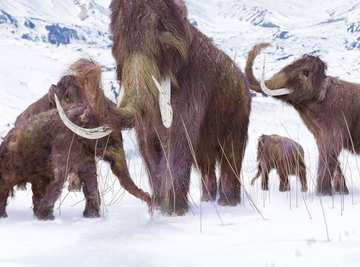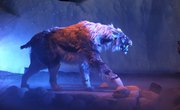
The Quaternary Period began 1.8 million years ago with an ice age. Many scientists refer to the period as the Age of Mammals, or sometimes the Age of Humans because hominids developed along with other Quaternary era animals. All of the plants and animals seen today are part of the Quaternary Period; however, there are also extinct animals and plants that lived on the Earth during the early Quaternary.
The Two Epochs
The Quaternary Period is divided into two major epochs; the “Pleistocene” and the “Holocene.” The Pleistocene epoch started 1.8 million years ago and ended around 11,000 years ago, while the Holocene started 11,000 years ago and continues today. The two epochs have two major differences: geography and climate. Although these characteristics play a major role in supporting flora and fauna, the Pleistocene epoch had some unique animals that did not survive into the Holocene. The Pleistocene epoch was characterized by the series of ice ages that occurred during its time, while the Holocene epoch has had a warmer climate, so far.
Quaternary Period Plants
Even though there are major climatic differences between the Pleistocene and the Holocene epochs, much of the plant life didn’t change. The Pleistocene epoch had two major climate conditions: the glacial and the interglacial. During the glacial period, great ice sheets covered large portions of Earth, and areas of tundra which included mosses, sedges, shrubs, lichens and low-lying grasses expanded. Sea levels were lower during these ice ages. During interglacial periods, or the times when most of the ice retreated, woodlands and coniferous forests proliferated. Sea levels rose again as the ice sheets melted.
The emergence of tropical rainforests occurred during the start of the Holocene epoch. This habitat allowed many animals and plants to thrive and evolve. Coniferous and deciduous forests thrived during this period, as well as grasslands, where herbivores grazed and flourished. Some scientists suggest that the spread of grasslands contributed to the development of humanids.
Quaternary Period Animals
The climatic change at the end of the Pleistocene also marks a change in animal life. Most of the large mammals of the Pleistocene went extinct, opening many niches for their smaller cousins to inhabit and thrive. A few of the Pleistocene megafauna still share the Earth, however. The blue whale, for example, is a remnant from the Pleistocene. Great white sharks, small distant cousins to the Pleistocene's 50-foot-long Megalodon, continue to terrorize the ocean.
Animals of the Pleistocene Epoch
Megafauna, especially large mammals, thrived during the Pleistocene period. Some of the better-known giant mammals of the Pleistocene epoch include woolly mammoths, mastodons, saber-toothed tigers, cave bears and giant deer. North America's Pleistocene animal population resembled modern Africa, with camels and wooly mammoths hunted by packs of saber-toothed cats and giant lions. True horses also roamed the North American plains, giant beavers inhabited rivers and teratorn birds with 25-foot wingspans hunted their prey. The giant megalodon shark prowled the oceans, hunting whales and other giant beasts. With the exception of horses and whales, all of these animals became extinct as the Earth's climate settled into its modern pattern. Horses did become extinct in North America but survived elsewhere and were re-introduced to North America by Europeans.
There are two major schools of thought as to why the huge land animals became extinct: “over-chill” and “over-kill.” Scientists who subscribe to the "over-chill" hypothesis say that all the large animals disappeared because they couldn’t keep up with the climate changes. This hypothesis can be applied to the extinction of other animals, including the megalodon. Scientists who support the "over-kill" hypothesis believe that hominoids, our ancestors, hunted most of the land animals to extinction. Evidence of over-kill includes large piles of bones with broken spear points and other weapons.
Animals of the Holocene Epoch
All the animals seen today are related to species from the Pleistocene period. From elephants and tigers to great white sharks and dolphins, quaternary period animals share genetic relationships to their larger counterparts that existed during the Pleistocene. The rise in temperature and the relative stability of the Holocene climate also allowed tropical and temperate rainforests, deciduous and coniferous forests as well as ice caps and deserts to develop. The variety of ecosystems during the Holocene period supports an amazing diversity of life.
References
- Fossil Facts and Finds: The Quaternary Period
- University of California Museum of Paleontology: The Pleistocene Epoch
- Illinois State Museum: Late Pleistocene Extinctions
- UCLA Newsroom: Large, Violent Animal Packs Shaped the Ecosystems of the Pleistocene Epoch
- National Geographic: Megalodon-The Monster Shark's Dead
About the Author
Steve Johnson is an avid and passionate writer with more than five years of experience. He's written for several industries, including health, dating and Internet marketing, as well as for various websites. He holds a bachelor's degree from the University of Texas.
